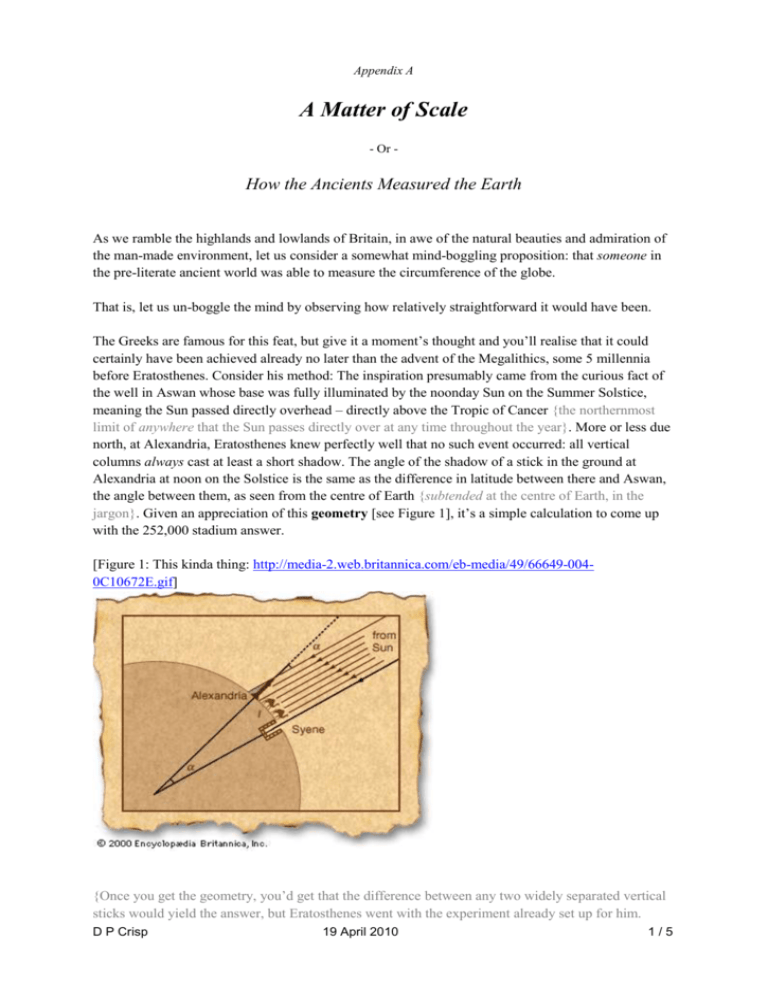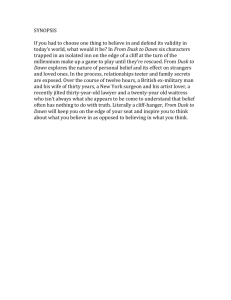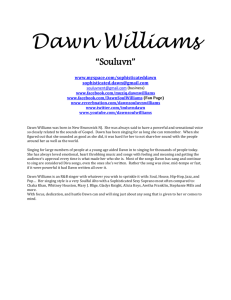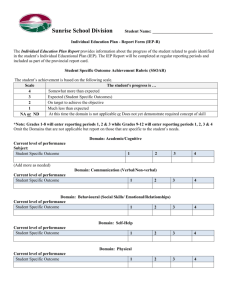Appendix A - The Megalithic Empire
advertisement

Appendix A
A Matter of Scale
- Or -
How the Ancients Measured the Earth
As we ramble the highlands and lowlands of Britain, in awe of the natural beauties and admiration of
the man-made environment, let us consider a somewhat mind-boggling proposition: that someone in
the pre-literate ancient world was able to measure the circumference of the globe.
That is, let us un-boggle the mind by observing how relatively straightforward it would have been.
The Greeks are famous for this feat, but give it a moment’s thought and you’ll realise that it could
certainly have been achieved already no later than the advent of the Megalithics, some 5 millennia
before Eratosthenes. Consider his method: The inspiration presumably came from the curious fact of
the well in Aswan whose base was fully illuminated by the noonday Sun on the Summer Solstice,
meaning the Sun passed directly overhead – directly above the Tropic of Cancer {the northernmost
limit of anywhere that the Sun passes directly over at any time throughout the year}. More or less due
north, at Alexandria, Eratosthenes knew perfectly well that no such event occurred: all vertical
columns always cast at least a short shadow. The angle of the shadow of a stick in the ground at
Alexandria at noon on the Solstice is the same as the difference in latitude between there and Aswan,
the angle between them, as seen from the centre of Earth {subtended at the centre of Earth, in the
jargon}. Given an appreciation of this geometry [see Figure 1], it’s a simple calculation to come up
with the 252,000 stadium answer.
[Figure 1: This kinda thing: http://media-2.web.britannica.com/eb-media/49/66649-0040C10672E.gif]
{Once you get the geometry, you’d get that the difference between any two widely separated vertical
sticks would yield the answer, but Eratosthenes went with the experiment already set up for him.
D P Crisp
19 April 2010
1/5
Allegedly.} Depending on what he meant by ‘a stadium’, this is either a bit out (16%) or bang on
(1%), but even at worst, it’s squarely in the right ball park. The problem was a logistical one: how to
measure the distance between Alexandria and Aswan. This was either “common knowledge” because
a camel train makes the trip in so long; or was measured especially for this influential Eratosthenes
character. Nothing the Megalithics – well, anyone with... um... legs, really – couldn’t have done. Stick
and string technology, as it were.
Concepts of geometry and measurement were necessary of course, but the Megalithics certainly had
those in spades. What they didn’t have was the advantage of Egyptian geography, but that doesn’t
mean they couldn’t manage some equivalent technique.
First, let us dismiss the matter of scale summarily: all you need to measure cross-country distances is
plenty of time. Whatever you think of hunter-gatherer and early agricultural societies, the grandeur
and range of megalithic structures speaks of organisation, time and geometry, if nothing else. So,
what could we do with stick-and-string technology and plenty of brains and plenty of time?
Well, maybe we could take up a high vantage point and note the rate at which the shadow of a total
eclipse races across the countryside... or find the distance to the horizon... but let us consider a
particularly British solution.
Britain isn’t the best place to see many total eclipses, but let’s stick with the shadow advancing across
the countryside theme.
The first and simplest step is to realise that the Earth turns one full circle in a day. The dawn, the edge
of the shadow dispelled by the sunrise, therefore sweeps out 360 degrees in 24 hours. (The actual
units of measure might be heart beats, pendulum swings... paces, horizons... whatever: it doesn’t
matter.)
To put it the other way, it takes time for the sunrise to pass along from place to place. If we can
measure this time difference across a known distance, then we can extrapolate: measured interval is to
measured distance as 24 hours is to circumference of Earth.
Where shall we se up this line (distance) to measure? If we have 2 or more observation posts in a
north-south chain, then the sunrise will be more or less simultaneous for them all and there won’t be
any time difference to measure. What we need is an east-west line, perpendicular with the dawn, to
get the most direct measure of the speed of the shadow of the sunrise. More specifics later, but the
logistical problem is to arrange a near-as-we-can-get-it straight line of observation posts running from
coast to coast, to give us the biggest time interval, the easiest to measure. In the process, we measure
the total distance from coast to coast. This defines a sector of a circle with an unknown angle
subtended at the centre of Earth.
The time it takes the Sun to sweep this distance equates to the angle and the angle tells us the overall
size of the sector... the whole circle... the Earth. The task of the observation posts is therefore to
measure the time.
Rather, the last is the only one to make the observation; the rest are signalling stations.
The first, east coast observer sends a signal – lights a fire? -- the instant he sees the Sun breech the
horizon. The next observer, having seen the fire but not (quite yet) the Sun, lights his beacon, too.
And so on, flashing a signal across the countryside: “sunrise has been seen in the east”.
D P Crisp
19 April 2010
2/5
Fire is surely the only option, but do we wave torches, shoot fire arrows, hoist fire baskets, light
bonfires...? The bigger the fire – hence, the farther away it can be seen – the longer it will take to get
going. We need some trial and error – established for practical purposes long before this experiment
was ever set up, for all we know – to work out an effective compromise: a signal easy enough to spot
from a fair distance, but easy enough to relay quickly. The shorter the range, the more signal stations
are needed and the more the delays are repeated.
We only need to keep pace with the dawn, though, as long as we can measure or estimate the time
each leg of the relay race takes. Too slow and it’ll be hard to see the lights against the brightening
sky... but if we consider a volley of fire arrows shot high into the air, we can probably ‘cross’ 10 miles
in a matter of seconds. That is, literally with sticks and string, we can send our sunrise signal ahead of
the Dawn – which takes about a minute to stride 10 miles across Britain – with some, if not a good,
margin.
So, we prepared the track carefully and the race is on. The first across the finish line at the western
end of our chain is the signal to say the Sun has risen in the east. To all intents and purposes – because
we can gauge the time it takes to send it form one station to the next and allow for it in the calculation
– this signal is simultaneous with that eastern sunrise.
Some minutes later – then, twenty minutes... an hour... depending on the particulars of the experiment
– the sunrise itself arrives in the west.
And that’s all there is to it. Once we know how long it actually takes to cover our prepared route, then
we know what proportion of a full circle it covers and therefore the overall circumference of the
circle. This is quite an achievement, but quite achievable: a figure like 15,000 miles or so – as the 10
mile per minute Dawn would have told them -- is the right order of magnitude. It doesn’t seem much
of a stretch of the imagination to suppose that their long-distance navigation and geometrical skill
were furthermore up to the task of discerning our 50 degrees-or-so latitude and extrapolating to a
25,000 mile-or-so overall circumference.
A tantalising echo of the method
we propose? This so-called Iron
Age house, excavated on a hilltop
adjacent to the Watling Street,
looks due east towards Waulud’s
Bank, a ditch-and-bank enclosure
on the Icknield Way. It faces the
Equinox sunrise rather than the
May Day one, but the curious
arrangement of wide aperture
“doorway” and D-shaped device
look less homely than solar-orastronomical observatory. They
weren’t short of timber, and yet a
single log was spit into two
uprights: surely an east-facing
panel with a slit rather than a roof
D P Crisp
19 April 2010
3/5
support. And adjacent to this, signs of a small fire: such as for lighting fire arrows or torches to
announce the observed astronomical event, or just for warmth in the cold before dawn?]
Let us respect what our ancestors were surely capable of (with sticks and strings), but let us also
deliver the punch line. The line of observation posts, that is: the very particular experimental
particulars that make this a British solution.
We observed initially that the signal line would preferably be at right angles to the advancing Dawn.
But that is a moving target. At the Vernal and Autumnal Equinoxes, when the Poles of the Earth lie on
the edge of the shadow of the dark side, the Dawn follows the lines of longitude. That is to say, the
Sun rises due east and travels horizontally, along the lines of latitude, as it were. But the island is
taller than it is wide: there aren’t that many long straight lines to be drawn straight across, east to
west. Longer is better, remember: more of a time delay to measure means better accuracy.
At other times of year, the North Pole points towards the Sun or away from it, or somewhere in
between and the angle at which the Dawn meets us varies accordingly, as in Figure 3.
[Figure 3: Dawn across Britain Winter Solstice; Dawn across Britain Summer Solstice; somewhere
between these 2 is suitable on a suitable date.]
So what is the compromise? When and where can we find the longest possible line across Great
Britain that is perpendicular to the Dawn, in line with the rising Sun?
Well, as John Michell will tell you, that is the description of the so-called Saint Michael Line, or
Dragon Line, running from St. Michael’s Mount in Cornwall, through Glastonbury and Avebury (and
Waulud’s Bank) and meeting the North Sea on the Norfolk coast. Traditionally, the Sun rose over this
line on May Day: Beltane, the Celtic festival whose name implies both fire and brightness. How
fitting.
At the opposite end of the year, the beginning of November, the Sun sets on the same line (and our
relay race could easily be repeated). That festival is called Samhain: the Celtic New Year, better
known as Halloween, also celebrated with fire (though, in Britain, the bonfire celebrations are now
settled on the 5th of November).
The sunrise and the east are associated with life, while the western sunset denotes death. A fire
festival celebrating life, looking to the sunrise, and a fire festival commemorating death, looking to
the sunset on the Dragon Line {or “Drawn Line”, since the letter g sometimes functions as a u}?
Well, naturally!
As Michael Harper will tell you, this is of worldwide significance. Have you ever noticed that while
we describe ours as a Solar Calendar, the Solstices and Equinoxes {the Quarter Days: astronomical
events where the Sun does something particular and observable} actually fall on “odd” days,
somewhere around the 20th to 23rd of March, June, September and December? The so-called CrossQuarter Days are not celebrated exactly between the Quarter Days, but on the nearest first of the
month, in February, May, August and November. At first, you might think that is because “half way
between two marked events” is not something the Sun pin-points in the sky, but why then is the
calendar not aligned to the Quarter Days, with the Cross-Quarter Days celebrated on... whatever
happen to be convenient dates?
D P Crisp
19 April 2010
4/5
Because, in the Celtic case, and thence the rest of the Western calendar-using world, May
Day/Halloween is not fully arbitrary, but fixed in relation to the geography of Great Britain, by the
location of that ‘drawn’, St. Michael Line. The other dates of the calendar then take their places, not
by aligning with events in the Heavens, but by aligning to a process of measuring the Heavens. After
all, ‘month’ has the same root as mensuration and the Sun, Moon and measurement intertwine in the
notion of a calendar.
“But our calendar derives from that of the Romans,” I hear you cry. That may be so, but let us be
reminded of a curious anomaly in the Roman system. Janus was the god of doorways and new
beginnings and his festival was always celebrated in January. That is why, they tell us, the New Year
was moved to January. What’s that: a celebration that could not be more equated with the New Year
that did not take place at the New Year? Well, “September, October, November, December” tell us
explicitly when the 7th, 8th, 9th and 10th months used to be, don’t they?
The curious thing, though, is that nova, as well as nine, means new and it is the Celtic New Year,
celebrated with fire as the Sun sets over the St. Michael Line drawn in Great Britain, that begins with
November.
D P Crisp
19 April 2010
5/5






